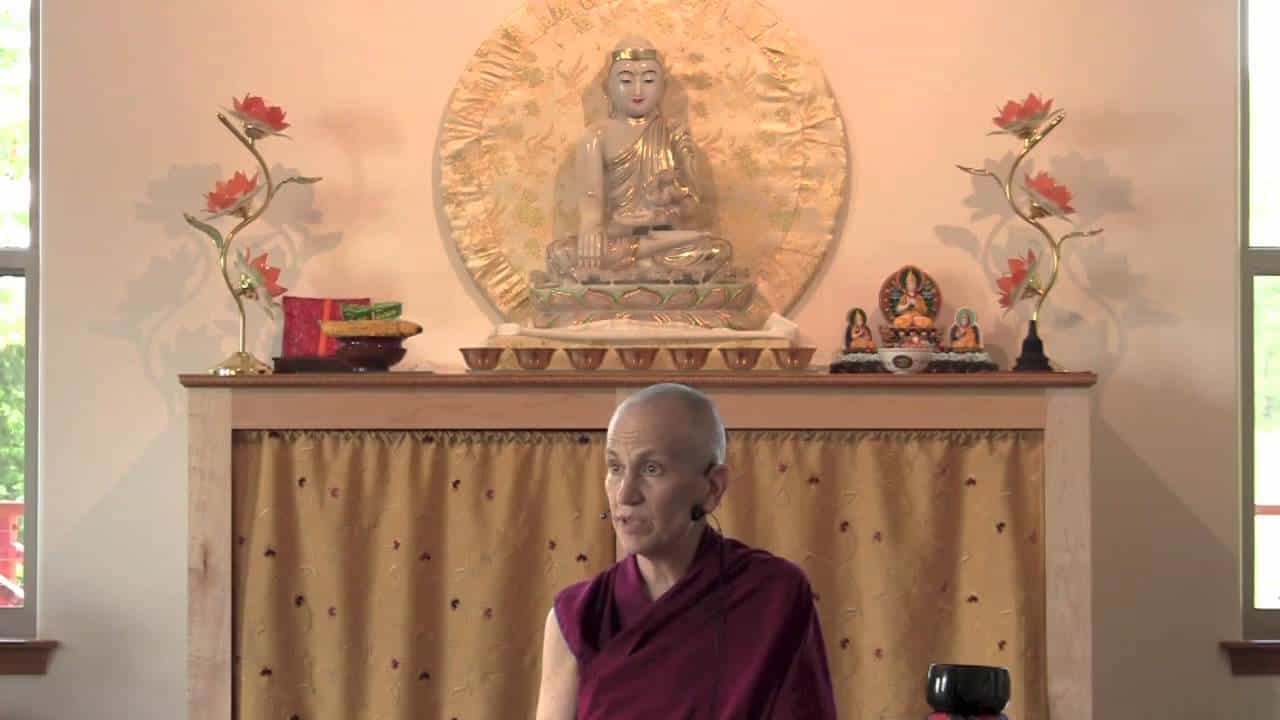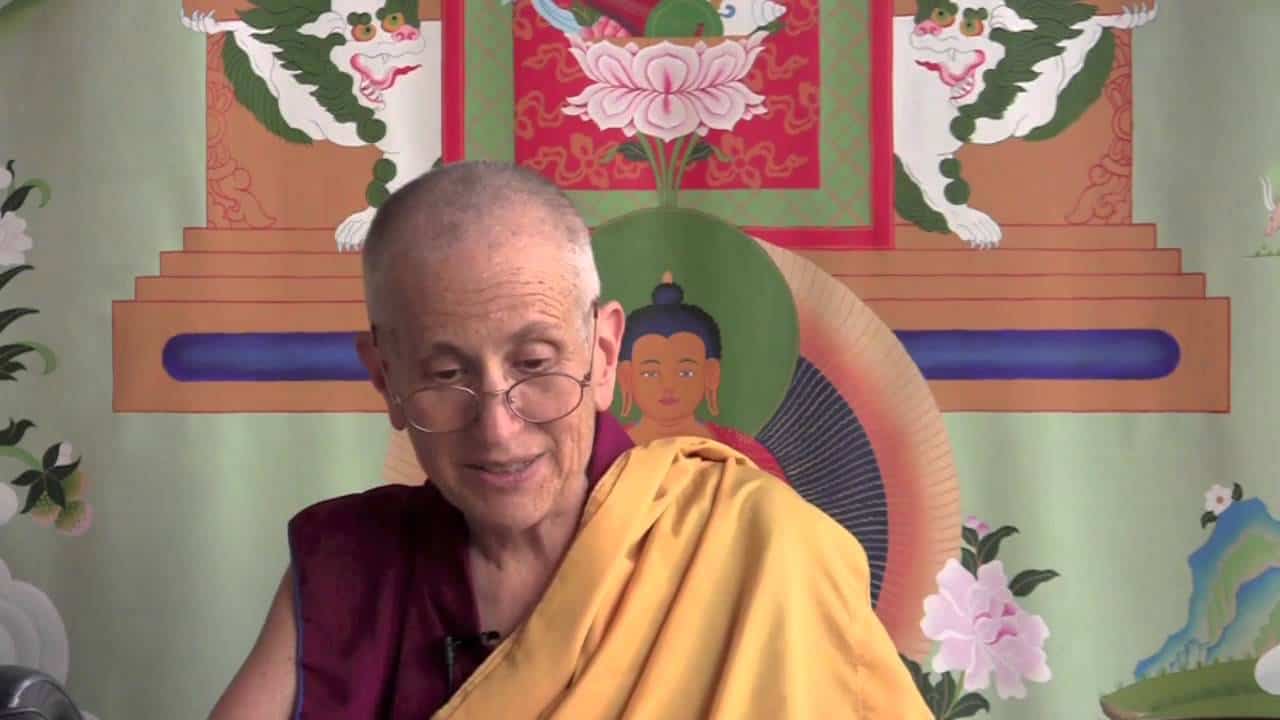Verse 107: The legs and eyes of the path
Part of a series of talks on Gems of Wisdom, a poem by the Seventh Dalai Lama.
- Method and wisdom, like two wings of a bird
- Method: renunciation, bodhicitta, bodhisattva’s deeds
- Wisdom: realizing the ultimate nature
- How method and wisdom are put together, and how each are necessary
Gems of Wisdom: Verse 107 (download)
What are the legs and what are the eyes of those who travel to omniscience?
The varieties of spiritual methods are the legs, and the eyes are the wisdom seeing the ultimate mode of things.
When we talk about progressing on the Bodhisattva Vehicle we talk about method on one hand and wisdom on the other, and they’re often compared to two wings of the birds—you need both wings to fly. One wing alone won’t do it.
The method side of the path refers to generating renunciation, generating bodhicitta, and then the bodhisattva deeds of generosity, ethical conduct, fortitude. And then the wisdom side of the path refers to the wisdom—realizing the ultimate nature. (Not the wisdom of how to benefit sentient beings and the wisdom of the arts and sciences. Those go into the method side. Because remember last week in the Easy Path teachings we talked about those three kinds of wisdom. So not all of them belong in the wisdom side.) And then shamatha (or serenity meditative stabilization) usually goes with wisdom, but it can also go with method. And joyous effort goes with both. So there you have the six perfections divided between wisdom and method.
Although there are other ways of dividing them, too. Some other scholars say that the first five are method and the last one is wisdom, giving the analogy of the method ones are (well, like here) like the legs and then the wisdom can see where you’re going. So you need both to be able to have the mode of moving and the eyes to know where you’re going. Otherwise you’ll either go around in circles, or you will stand still. So we need both of them. So, there are different ways of dividing up the six perfections between method and wisdom.
In any case, both method and wisdom are important and are necessary. And they need to be combined. So in the paramita path (the Perfection Vehicle path) we combine them by when meditating on emptiness doing it with a motivation of bodhicitta so that the wisdom realizing emptiness is supported (or sustained, or conjoined) with the bodhicitta motivation. And then you conjoin the wisdom with the method, or use wisdom to support the method side, when you’re doing different bodhisattva actions. For example, contemplating—when you give generosity—that yourself as the one who’s giving, the object that’s being given, the recipient, the action of giving, that all of these are empty of true existence and yet exist dependently. That way you’re doing a method practice but it’s supported by your wisdom. So in the Perfection Vehicle that’s how you put method and wisdom together.
In the Vajra Vehicle then you’re trying to put them together in one consciousness. Because the idea is—in the Perfection Vehicle—when you’re doing a method practice your understanding of wisdom cannot be direct, it’s going to be conceptual in supporting the wisdom aspect of the path. And when you’re meditating on emptiness and bodhicitta is supporting it, the bodhicitta isn’t manifest in the mind at that time. So in the Perfection Vehicle path you can’t have method and wisdom manifest in the mind at the same time until you attain buddhahood.
In the Vajra Vehicle it has very skillful means to try and bring method and wisdom together in one consciousness. For example, when you’re doing deity yoga practice you dissolve into emptiness, you think that the wisdom realizing emptiness appears in the form of the deity, and then you meditate on the emptiness of the deity again. And then the deity appears but it’s empty. So you go back and forth between these two—between conventional truth and ultimate truth. The method side of the path is more the conventional truth side, the wisdom side of the path is the ultimate truth side. So you go back and forth.
There are all these kind of correspondences. You start out with conventional truth and ultimate truth as the basis. Then on the path, for conventional truth, you have the method side of the path, and for the ultimate truth you have the wisdom side of the path. And then for the results of the path, for the method side you have the form bodies of the Buddha (the enjoyment body and the emanation body), and for the wisdom side of the path you have the dharmakaya. So that’s how you have these correspondences with the basis, the path, and the result.
It’s handy to have those correspondences because you start out, here’s the basis, you have conventional truths and ultimate truths; on the path this is how you practice them, and use them, and transform them, and develop them; and then on the result this is what you’re attaining, the different buddha bodies from that.
So those are the eyes and the legs of the path. And we need both.
Try and remember these correspondences. It’s very, very helpful for you when you come across different teachings.
[In response to audience] Yes, in the Perfection Vehicle that’s how you’re combining wisdom with method. Because your main practice at that time is method, because you’re practicing generosity or ethical conduct or something like that. And then you support it by wisdom as you’re doing it or after you’ve done it reflecting on the emptiness of all these components. In that way we don’t cling to the merit that we create.
Another correspondence with these is the “collection of merit” refers to the method aspect of the path, and the “collection of wisdom” refers to the wisdom aspect of the path.
We’ll come to those in Precious Garland. [Current Thursday night teachings.] Nagarjuna talks about this.
Venerable Thubten Chodron
Venerable Chodron emphasizes the practical application of Buddha’s teachings in our daily lives and is especially skilled at explaining them in ways easily understood and practiced by Westerners. She is well known for her warm, humorous, and lucid teachings. She was ordained as a Buddhist nun in 1977 by Kyabje Ling Rinpoche in Dharamsala, India, and in 1986 she received bhikshuni (full) ordination in Taiwan. Read her full bio.


